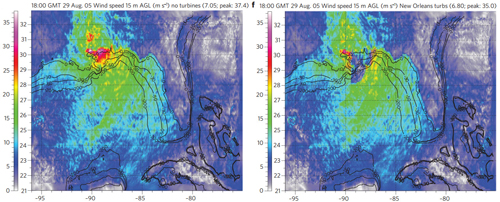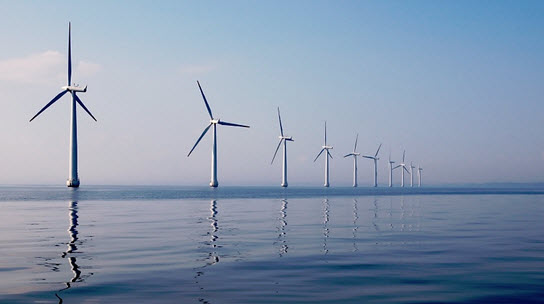Offshore wind farms could tame hurricanes before they reach land, Stanford-led study says
February 26, 2014
Computer simulations by Stanford Professor Mark Z. Jacobson have shown that offshore wind farms with thousands of wind turbines could have sapped the power of three real-life hurricanes, significantly decreasing their winds and accompanying storm surge, and possibly preventing billions of dollars in damages.
For the past 24 years, Jacobson, a professor of civil and environmental engineering at Stanford, has been developing a complex computer model to study air pollution, energy, weather and climate. A recent application of the model has been to simulate the development of hurricanes. Another has been to determine how much energy wind turbines can extract from global wind currents.
In light of these recent model studies and in the aftermath of hurricanes Sandy and Katrina, he said, it was natural to wonder: what would happen if a hurricane encountered a large array of offshore wind turbines? Would the energy extraction due to the storm spinning the turbines’ blades slow the winds and diminish the hurricane, or would the hurricane destroy the turbines?
So he went about developing the model further and simulating what might happen if a hurricane encountered an enormous wind farm stretching many miles offshore and along the coast. Amazingly, he found that the wind turbines could disrupt a hurricane enough to reduce peak wind speeds by up to 92 mph and decrease storm surge by up to 79 percent.
The study, conducted by Jacobson, and Cristina Archer and Willett Kempton of the University of Delaware, was published online in Nature Climate Change.
The researchers simulated three hurricanes: Sandy and Isaac, which struck New York and New Orleans, respectively, in 2012; and Katrina, which devastated New Orleans in 2005.

Simulation of Hurricane Katrina wind speeds in the absence (left) and presence (right) of offshore wind turbines, showing significant reduction (blue-purple) of wind speeds (in meters/sec) (credit: Mark Z. Jacobson et al./Nature Climate Change)
“We found that when wind turbines are present, they slow down the outer rotation winds of a hurricane,” Jacobson said. “This feeds back to decrease wave height, which reduces movement of air toward the center of the hurricane, increasing the central pressure, which in turn slows the winds of the entire hurricane and dissipates it faster.”
In the case of Katrina, Jacobson’s model revealed that an array of 78,000 wind turbines off the coast of New Orleans would have significantly weakened the hurricane well before it made landfall.
In the computer model, by the time Hurricane Katrina reached land, its simulated wind speeds had decreased by 80–98 mph and the storm surge had decreased by up to 79 percent.
For Hurricane Sandy, the model projected a wind speed reduction by 78–87 mph and as much as 34 percent decrease in storm surge.
Financial incentives for wind turbines in hurricane zones
Jacobson acknowledges that, in the United States, there has been political resistance to installing a few hundred offshore wind turbines, let alone tens of thousands. But he thinks there are two financial incentives that could motivate such a change.
One is the reduction of hurricane damage cost. Damage from severe hurricanes, caused by high winds and storm surge-related flooding, can run into the billions of dollars. Hurricane Sandy, for instance, caused roughly $82 billion in damage across three states.
Second, Jacobson said, the wind turbines would pay for themselves in the long term by generating normal electricity while at the same time reducing air pollution and global warming, and providing energy stability.
“The turbines will also reduce damage if a hurricane comes through,” Jacobson said. “These factors, each on their own, reduce the cost to society of offshore turbines and should be sufficient to motivate their development.”
An alternative plan for protecting coastal cities involves building massive seawalls. Jacobson said that while these might stop a storm surge, they wouldn’t impact wind speed substantially. The cost for these, too, is significant, with estimates running between $10 billion and $40 billion per installation.
Current turbines can withstand wind speeds of up to 112 mph, which is in the range of a category 2 to 3 hurricane, Jacobson said. His study suggests that the presence of massive turbine arrays will likely prevent hurricane winds from reaching those speeds.
Abstract of Nature Climate Change paper
Hurricanes are causing increasing damage to many coastal regions worldwide. Offshore wind turbines can provide substantial clean electricity year-round, but can they also mitigate hurricane damage while avoiding damage to themselves? This study uses an advanced climate–weather computer model that correctly treats the energy extraction of wind turbines to examine this question. It finds that large turbine arrays (300+ GW installed capacity) may diminish peak near-surface hurricane wind speeds by 25–41 m s−1 (56–92 mph) and storm surge by 6–79%. Benefits occur whether turbine arrays are placed immediately upstream of a city or along an expanse of coastline. The reduction in wind speed due to large arrays increases the probability of survival of even present turbine designs. The net cost of turbine arrays (capital plus operation cost less cost reduction from electricity generation and from health, climate, and hurricane damage avoidance) is estimated to be less than today’s fossil fuel electricity generation net cost in these regions and less than the net cost of sea walls used solely to avoid storm surge damage.
